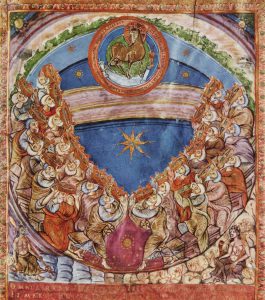 Historic premillennialism is a view that was championed by George Ladd and is therefore commonly associated with him. Ladd was primarily responding to dispensationalism. The adjective “historic” in historic premillennialism refers to Ladd’s contention that some early Church Fathers were clearly premillennial, but none of them believed in the pretribulational rapture of the church (Ladd, Blessed Hope, 19-31). As a result, the chief distinctive of historic premillennialism is belief in a single return of Christ that will take place before his millennial reign. Like amillennialists, historic premillennialists also believe in a posttribulational rapture of the church. This means that the church will be present on earth during the tribulation under the Beast. Even so, Revelation assures Christians that they are secure with God even if they die a martyr’s death (Rev. 11:1-2; 12:11) and God will protect them from his wrath on the Beast and his followers (Rev. 7:3-4).
Historic premillennialism is a view that was championed by George Ladd and is therefore commonly associated with him. Ladd was primarily responding to dispensationalism. The adjective “historic” in historic premillennialism refers to Ladd’s contention that some early Church Fathers were clearly premillennial, but none of them believed in the pretribulational rapture of the church (Ladd, Blessed Hope, 19-31). As a result, the chief distinctive of historic premillennialism is belief in a single return of Christ that will take place before his millennial reign. Like amillennialists, historic premillennialists also believe in a posttribulational rapture of the church. This means that the church will be present on earth during the tribulation under the Beast. Even so, Revelation assures Christians that they are secure with God even if they die a martyr’s death (Rev. 11:1-2; 12:11) and God will protect them from his wrath on the Beast and his followers (Rev. 7:3-4).
A historic premillennial interpreter of Revelation will have much in common with an amillennial interpreter, like Beale (see post on ammillennialism). Both will generally be open to the possibility that numbers in Revelation are symbolic. Both will tend to see significant continuity between Israel and the church. This makes it possible, for example, to interpret “Israel” in Revelation 7:4 with reference to the fullness of the people of God, which is composed of both Jews and Gentiles. The historic premillennialist diverges from the amillennialist when it comes to interpreting the millennial reign of Christ (Rev. 20:1-6).
Historic premillennial interpreters do not all agree on how much of Revelation describes events that begin in the present and continue until the second coming of Christ. In addition to the timing of the millennium, some would disagree with other aspects of Beale’s amillennialist interpretation. They might think, for instance, that the three and a half year reign of the Beast did not begin in the past, but belongs solely to the future (Beasley-Murray, Revelation, 200-1; Osborne, Revelation, 464). Most would disagree with Beale regarding the timing of the 21 judgments, especially the trumpets and the bowls. They would see these as predictions of future, cataclysmic events that are much worse than anything that the world has ever seen (Osborne, Revelation, 374).
My Approach to the Book of Revelation: A Historic Premillennial Approach
In light of the diverse approaches to the book of Revelation outlined in these posts, one can appreciate why it is helpful for any commentary writer to indicate clearly their approach to the book. In my commentary, I provide an interpretation that emphasizes the already (realized eschatology) and the not yet (consummated eschatology) aspects of the book of Revelation. In doing so, I point out aspects of the book that begin in the past and continue until the second coming of Christ (the “already” aspects of the book). For instance, I think that the judgments associated with the first four seals (Rev. 6:1-8) begin to occur after the exaltation of Christ to heaven (12:5) and continue until the great day of God’s wrath (6:17). Similarly, the three and a half year reign of the Beast (Rev. 13) is a symbolic time period. It begins with the exaltation of Christ (12:5-6) and continues until Christ defeats the Beast (Rev. 19).1 This allows for the fact that John was already experiencing tribulation due to the reign of the Beast in the first century, as Revelation 1:9 shows. Both the Christians to whom John ministered and Christians today are subject to the rule of the Beast in the world. Yet, unlike the preterist and the amillenialist, I think that a good bit of the book of Revelation relates exclusively to the future and the second coming of Christ. For instance, the judgments associated with the end events and the second coming of Christ include the sixth and seventh seals, the seven trumpets, and the seven bowls. Unlike the amillennialist, I think that the millennium lies in the future as well, after Christ vanquishes the Beast and his armies.
Notes:
1. Craig Keener (Revelation, 318-20), Robert Mounce (Revelation, 236), and Mathias Rissi (Time and History, 39-41) are clear examples of historic premillennialists who take the same position.
Sources:
These paragraphs represent an edited portion of my book:
Paul Hoskins, The Book of Revelation: A Theological and Exegetical Commentary, pp. 34-36 (these pages provide further sources and footnotes that I have omitted above).
